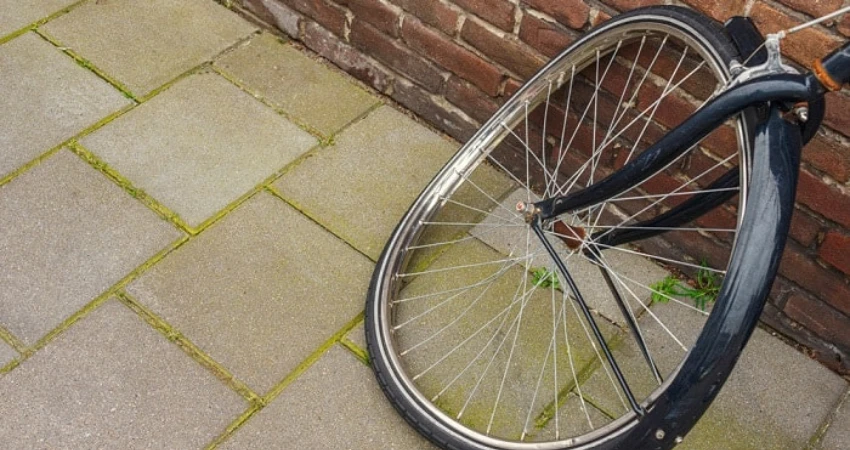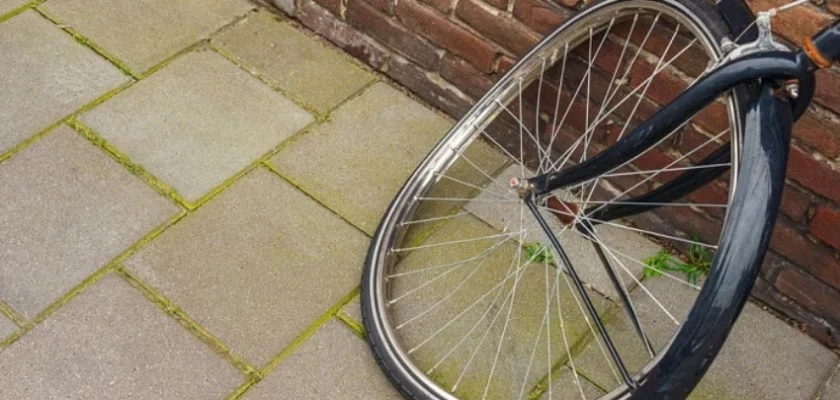Got a bike tire that’s acting a little wonky? Don’t worry, we’ve got you covered. In this blog article, we’ll show you how to fix a warped bike tire and get you back on the road in no time. No need to spend a fortune at the bike shop – with a little know-how and a few simple tools, you can easily tackle this common issue yourself.
Picture this: you’re cruising along on your bike, enjoying the fresh air and freedom of the open road. Suddenly, you feel a wobble and hear a strange noise. Your heart sinks as you realize your tire is warped.
But fear not, fellow cyclist! This guide will walk you through the step-by-step process of how to fix a warped bike tire, ensuring a smooth and enjoyable ride once again.
No need to fret about your misaligned tire any longer. Let’s jump right in and uncover the secrets to restoring your bike’s performance with a simple fix for a warped bike tire.
Fix Warped Bike Tire: Easy Solutions

Riding a bike is not only a fun and healthy activity but also an eco-friendly means of transportation. However, one common issue that many cyclists face is a warped bike tire. A warped tire can make your bike feel unstable, reduce your overall control, and even lead to accidents if not addressed promptly.
Identifying a Warped Tire
Before diving into the procedure to fix a warped bike tire, it’s important to know how to recognize this issue. Here are a few signs that indicate you have a warped tire:
- Uneven contact patch: When you spin the wheel and observe the contact between the tire and the ground, you may notice that certain areas are not uniformly touching the surface.
- Wobbling or vibration: If you experience wobbling or a vibrating sensation while riding, especially at higher speeds, it is likely due to a warped tire.
- Visual cues: Inspect the tire for any irregularities, such as bulges, dents, or buckling. These are clear indicators of a warped tire.
Gather the Necessary Tools
To fix a warped bike tire, you’ll need a few basic tools. It’s always a good idea to gather them beforehand to have everything within reach when you start the repair process. Here’s what you’ll need:
- Adjustable wrench or socket wrench set
- Tire levers
- Bike repair stand or an alternative method to elevate your bike
- Spoke wrench
- Pump or air compressor
- Truing stand or substitute (such as zip ties or brakes pads)
- Pliers (optional, for stubborn spokes)
Preparation: Elevate Your Bike
To begin the process of fixing a warped bike tire, you’ll need to elevate your bike to a comfortable working height. This will help you perform the necessary adjustments with ease. There are different methods available to achieve this, including:
- Bike repair stand: Place your bike in a repair stand designed to hold it securely. This will allow you to freely rotate the wheels and access the problematic tire from any angle.
- Alternatives: If you don’t have a repair stand, you can flip your bike and rest it on its handlebars and seat. Alternatively, you can lean the bike against a wall or use a suspended rope to lift it.
Loosening the Brake Caliper
Before proceeding with the tire repair, it’s crucial to loosen the brake caliper in order to have sufficient clearance for adjustments. Follow these steps:
- Locate the brake caliper: It is usually positioned above or below the tire, attached to the bike’s frame or fork.
- Loosen the mounting bolt(s): Use an adjustable or socket wrench to loosen the mounting bolts on the caliper. This will allow the caliper to move freely.
- Adjust the caliper position: Move the caliper slightly so that it doesn’t interfere with the spinning wheel. Be careful not to push it too far, as it must remain aligned with the rim.
Identifying Spoke Tension Issues
Warped tires are often caused by improper spoke tension. Gauging the tension in each spoke can help you identify which ones need adjustments. Follow these steps:
- Tap the spokes with a non-metal object: Tap each spoke gently to listen to the sound it produces. A properly tensioned spoke will emit a higher-pitched sound, while a loose or over-tensioned spoke will produce a lower-pitched sound.
- Visually inspect the spokes: Look for any spokes that appear noticeably loose or overly tight. These are the ones that require adjustment.
- Mark the problematic spokes: Use a small piece of tape or a marker to clearly identify the spokes that need attention. This will make it easier to keep track during the truing process.
Using a Truing Stand (or Alternatives)
A truing stand is a specialized tool designed to make the process of aligning a bike tire easier. If you have access to one, follow these steps:
- Secure your bike in the truing stand: Place the bike in the stand, ensuring it is stable and securely held. Confirm that the wheel you want to true is positioned correctly.
- Spin the wheel: Rotate the wheel slowly and observe the points of contact between the tire and any truing stand arms. Pay attention to any areas that appear to be out of alignment.
- Locate the first problematic spoke: Identify the first spoke that requires adjustment. Reference the marked spokes or the ones you identified earlier.
- Adjust spoke tension: Using a spoke wrench, turn the nipple of the spoke clockwise to tighten or counterclockwise to loosen it. Make small adjustments, usually a quarter turn at a time.
- Check for improvement: Spin the wheel again to check if the adjustments have corrected the wobbling or warping. Repeat the process for any remaining problematic spokes until the tire is properly aligned.
If you don’t have access to a truing stand, you can use alternative methods to fix your bike tire. Here are two commonly used substitutes:
- Zip ties: Attach several zip ties to the frame or fork, positioning them near the tire. As the wheel rotates, the zip ties will act as visual guides, indicating areas where the tire is misaligned.
- Brake pads: Firmly secure the brake pads on either side of the rim, close to the tire. As the wheel spins, any discrepancies will cause rubbing or dragging against the brake pads, highlighting the areas that need adjustment.
Tire Reassembly and Final Adjustment
Once you have addressed all the problematic spokes and achieved a properly aligned tire, it’s time to reassemble and fine-tune the brake caliper. Follow these steps:
- Tighten the spoke nipples: Ensure all the spokes are tightened appropriately. Use a spoke wrench to adjust any remaining loose or tight spokes until the rim is uniformly aligned and centered.
- Reset the brake caliper: Position the caliper back into its original position so that it aligns with the rim. Tighten the mounting bolts securely.
- Test the reassembled tire: Spin the wheel and observe its rotation. Check for any signs of wobbling or misalignment. If necessary, make small adjustments to the spoke tension or caliper position until the tire runs smoothly.
Lowering the Bike
With the tire fixed and reassembled, it’s time to lower your bike from the repair stand or any alternative lifting method. Gently place the bike back on the ground, ensuring that it stands upright and doesn’t lean to one side.
Final Check and Maintenance Tips
Before hitting the road again, it’s essential to perform a final check to ensure your bike is safe to ride. Here are a few additional tips:
- Check tire pressure: Inflate the tire to the recommended pressure level as specified on the sidewall of the tire. This will optimize performance and prevent any potential issues.
- Test for stability: Take your bike for a short test ride on a flat surface, ensuring it feels stable and under control. Pay attention to any lingering wobbling or vibrations.
- Regular maintenance: To prevent future issues, inspect your bike tires regularly for signs of wear or damage. Also, keep the spokes properly tensioned and the tire properly inflated to minimize the risk of a warped tire.
Frequently Asked Questions
1. What causes a bicycle tire to become warped?
The most common cause of a warped bike tire is uneven tension in the spokes, which can result from various factors such as improper installation, heavy loads, or hitting potholes.
2. How can I tell if my bike tire is warped?
A warped bike tire can be identified by a wobble or noticeable unevenness while riding. When spinning the wheel, visually inspect for any visible deviations in its alignment or check if it rubs or hits the brake pads.
3. Can a warped bike tire be fixed at home?
Yes, minor warping can often be resolved at home. Start by tightening loose spokes evenly if present. If it doesn’t fix the issue, professional help may be necessary, especially for major warping or damaged rims.
4. How do I fix a minor warp in my bike tire?
To fix a minor warp, locate the affected area and tighten or loosen the appropriate spokes in small increments until the warp is diminished or eliminated. This should be done carefully and in a balanced manner to maintain overall wheel integrity.
5. Is it possible to prevent a bike tire from warping?
While it is challenging to prevent all instances of warping, proper maintenance can minimize the risk. Regularly checking and adjusting spoke tension, avoiding excessive loading, and navigating rough terrain carefully can help prevent warping to some extent.
Final Thoughts
To fix a warped bike tire, it’s important to first identify the cause of the warping, such as improper storage or frequent impact. Once identified, there are simple steps you can take to rectify the issue.
Begin by loosening the brake calipers and releasing any air pressure in the tire. Then, use a spoke wrench to adjust the tension of the spokes, gradually tightening or loosening them until the wheel becomes straight.
Lastly, ensure that the tire is properly aligned and centered before tightening the brake calipers and reinflating the tire. By following these steps, you can effectively fix a warped bike tire and get back on the road in no time.
Remember, prevention is always better than cure. Regularly inspect your bike tires for any signs of warping and address the issue promptly to avoid further damage.
Maintaining proper storage, avoiding rough terrain, and performing routine maintenance will help keep your bike tires in optimal condition. With the knowledge and tools to fix a warped tire, you can confidently hit the road and enjoy a smooth and safe ride.

